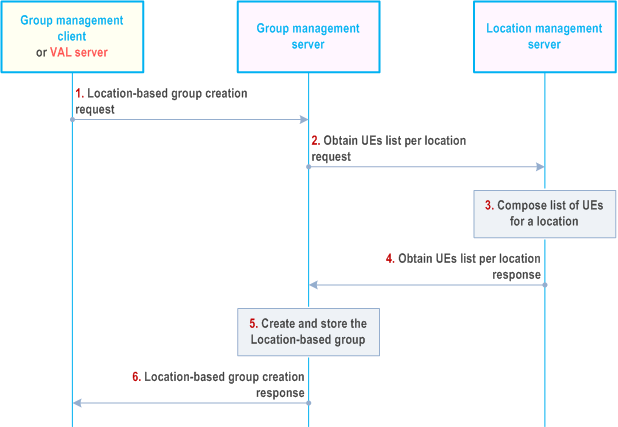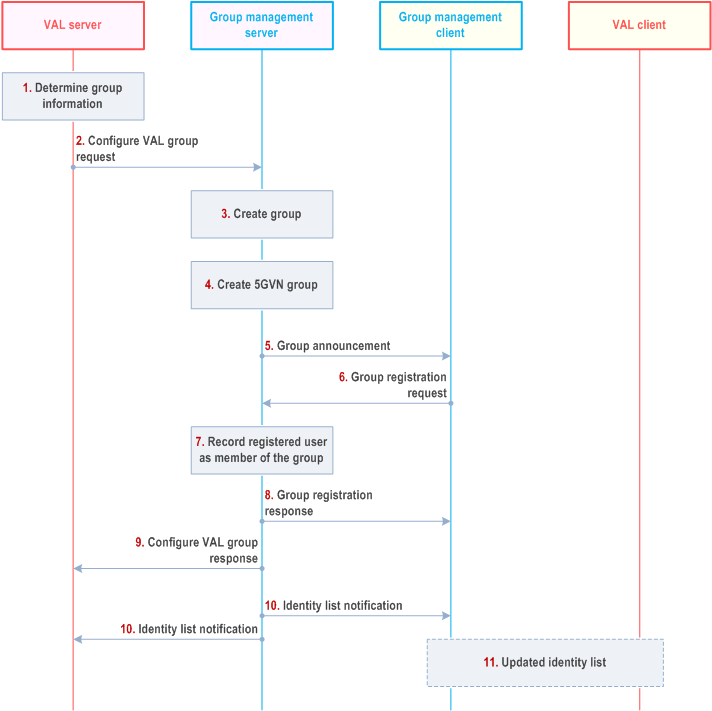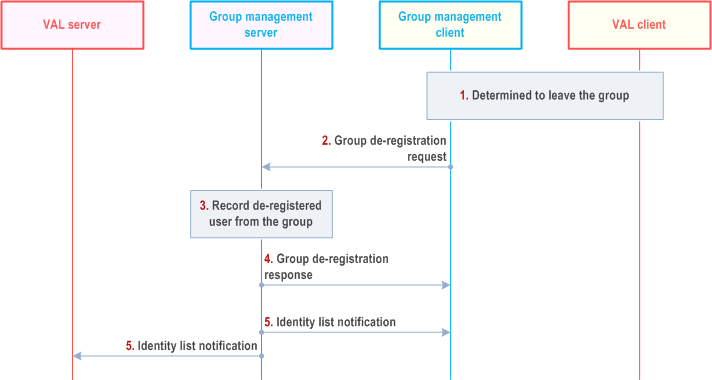Content for TS 23.434 Word version: 19.2.0
0…
4…
5
6…
6.4…
6.5…
6.5.3…
7…
8…
8.2.2…
9…
9.3…
9.3.2.21…
9.3.3…
9.3.6…
9.3.11…
9.3.13…
9.3.14…
9.4…
9.4.6…
9.5…
10…
10.3…
10.3.2.22…
10.3.3…
10.3.7…
10.3.10…
10.4…
11…
11.3…
11.3.3…
11.4…
12…
12.3…
13…
14…
14.2.2.2…
14.3…
14.3.2.20…
14.3.2.40…
14.3.3…
14.3.3.3…
14.3.4…
14.3.4.6
14.3.4.7…
14.3.4A…
14.3.4A.3…
14.3.4A.4…
14.3.4A.6…
14.3.4A.8…
14.3.4A.9…
14.3.4A.10…
14.3.5…
14.3.6…
14.3.9…
14.3.12…
14.4…
15…
16…
17…
18…
A
B…
10.3.7 Location-based group creation
10.3.8 Group announcement and join
10.3.9 Group member leave
...
...
10.3.7 Location-based group creation p. 123
Figure 10.3.7-1 below illustrates the location-based group creation.
Pre-conditions:
- The group management client, group management server, VAL server, location management server and the VAL group members belong to the same VAL system.
- The authorized VAL user/UE/administrator or VAL server is not aware of the users' or UE identities which will be combined to form the VAL group.

Step 1.
The group management client or the VAL server requests location-based group create operation to the group management server. The location criteria for determining the identities of the users or UEs to be combined shall be included in this message and the location criteria may be the VAL service area identified by the VAL service area ID.
Step 2.
The group management server requests the location management server for obtaining the users or UEs corresponding to the location information or the VAL service area identified by the VAL service area ID.
Step 3.
The location management server composes the list of users or UEs within the requested location.
Step 4.
The group management server receives the composed list of users or UEs from the location management server. The location management server may include VAL service IDs associated with the list of users or UEs.
Step 5.
During the group creation, the group management server creates and stores the information of the location-based group. The group management server performs the check on the policies e.g. maximum limit of the total number of VAL group members for the VAL group(s). If an external group identifier, identifying the member UEs of the VAL group at the 3GPP core network is available, then the external group ID is stored in the newly created VAL group's configuration information. If VAL service ID list was received in step 1 as part of group formation criteria and not in step 4 for the composed list of users or UEs, the group management server shall retrieve the VAL service data from the configuration management server as described in clause 11.3.2.13 and form the group with relevant users or UEs.
Step 6.
The group management server provides a location-based group creation response to the group management client or the VAL server.
10.3.8 Group announcement and join p. 124
10.3.8.1 General p. 124
This subclause describes the procedures for establishing group communication from the group management server to the group management clients.
10.3.8.2 Procedure p. 124
Pre-conditions:
- The group management client, group management server, VAL server and the VAL clients belong to the same VAL system.
- The VAL server is aware of the users' identities and is authorized to form a VAL group.

Step 1.
The VAL server determines group information and the identity list to which the group announcement shall be sent. The decision can be based on the list of authorized UEs and other criteria (e.g. user consent, service, or vehicle driving profile).
Step 2.
The VAL server configures VAL group for Uu communication defined by VAL Group ID for one or more VAL services with list of VAL Service ID with the group management server.
Step 3.
The group management server creates an empty group based on the information provided in the Configure VAL group request. The group management server stores the mapping between the VAL group ID and the external Group Id in the VAL group document, along with a list of GPSIs corresponding to the identity list provided by the VAL server. The group management server also determines whether the group is for 5G LAN-Type communication and whether Ethernet or IP (IPv4 and/or IPv6) transport shall be used for the 5G LAN-Type communication.
Step 4.
If 5G LAN-Type communication is to be used, the group management server creates a 5GVN group in the 5GS via N33 using the create group procedure specified in clause 5.29.2 of TS 23.501 and clause 4.15.6 of TS 23.502. The group management server creates the 5GVN group data and the 5GVN group membership data defined in clause 4.15.6.3b of TS 23.502 to be configured in the 5GS. To create the 5GVN group data the group management server uses the 5G LAN-Type communication type information provided by the VAL server to set the PDU session type (Ethernet or IP) and maps the VAL service IDs to Application descriptors. To create the 5GVN group membership data the group management server maps the VAL group ID to the External Group ID and makes a list of GPSIs corresponding to the identity list provided by the VAL server.
Step 5.
The group management server announces the VAL group to the group management clients. For a 5GVN group the announcement includes the communication type (IP or Ethernet), DNN, and S-NSSAI corresponding to the 5GVN group.
Step 6.
The group management client registers to VAL group communication using the VAL Group ID.
Step 7.
The group management server records the users who have registered to be the members of the group.
Step 8.
The group management server sends a VAL group registration response to the group management client.
Step 9.
The group management server sends a configure VAL group response to the VAL server.
Step 10.
The group management server sends identity list notification about the newly registered users to the other members of the group and VAL server, whose subscription to receive notifications of newly registered VAL UE IDs is successful in step 8 and step 9 respectively.
Step 11.
The group management client may inform VAL client about the updated identity list.
10.3.9 Group member leave p. 125
10.3.9.1 General p. 125
This subclause describes the procedures for group member to leave the group by de-registering.
10.3.9.2 Procedure p. 125
Pre-conditions:
- Group is previously defined on the group management server including the list of registered users and each member of the group and VAL server is aware of it.

Step 1.
The VAL client determines to de-register member from the group and group management client is aware of it.
Step 2.
The group management client initiates the group de-registration request towards the group management server.
Step 3.
The group management server checks the authorization of group de-registration request and updates the group member list.
Step 4.
The group management server sends a group de-registration response to the group management client.
Step 5.
The group management server sends identity list notification about the leaving registered user to the other members of the group and the VAL server, whose subscription to receive notifications of de-registered VAL UE IDs is successful in step 7 and step 8 of the procedure in clause 10.3.8.2 respectively.